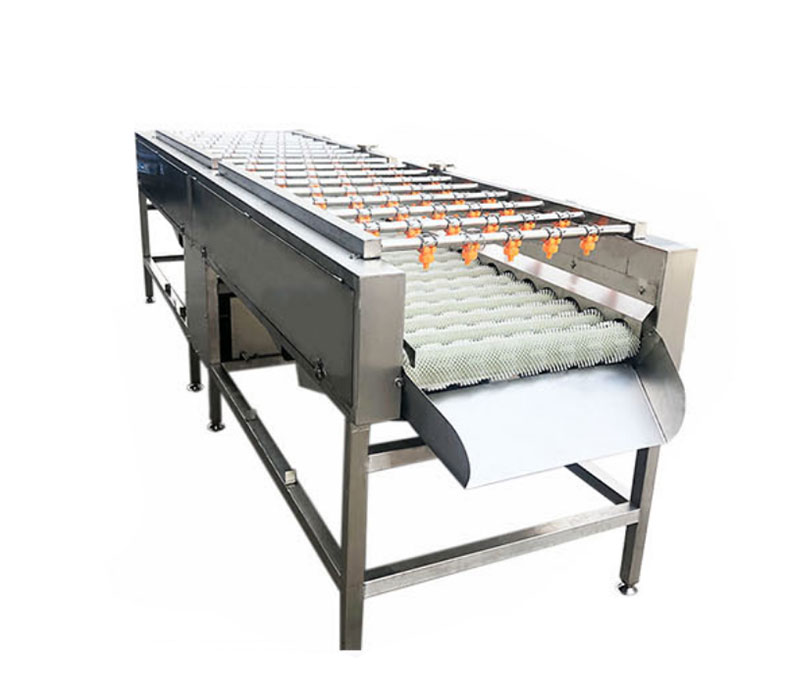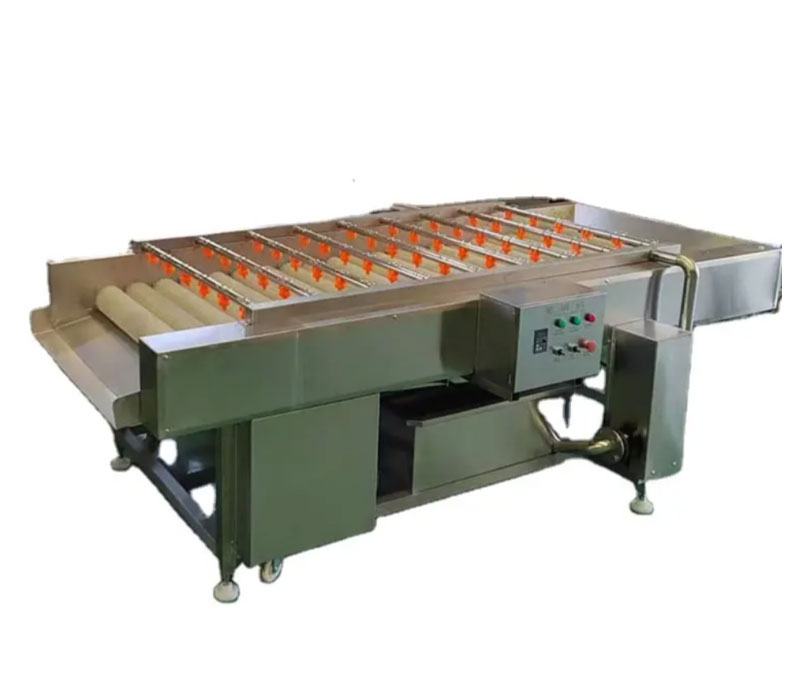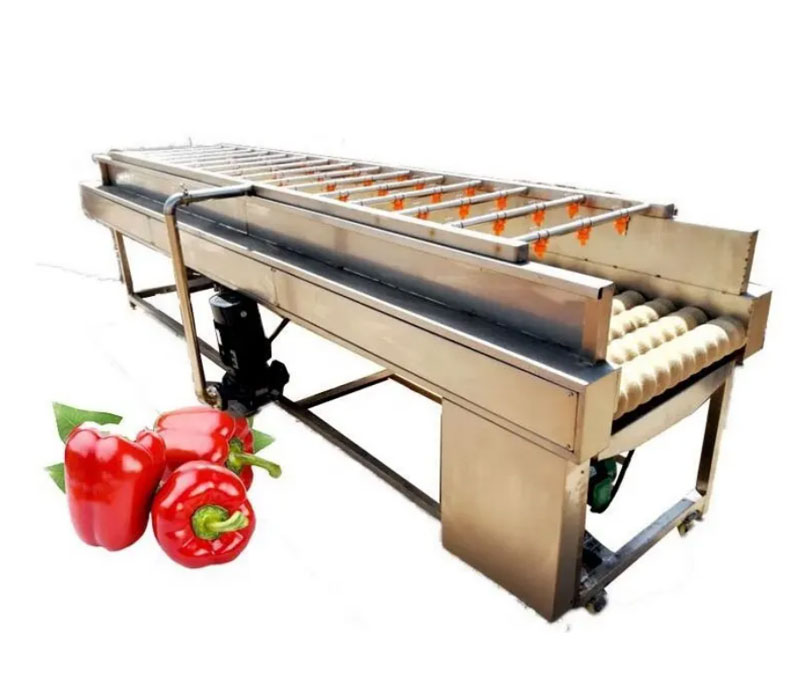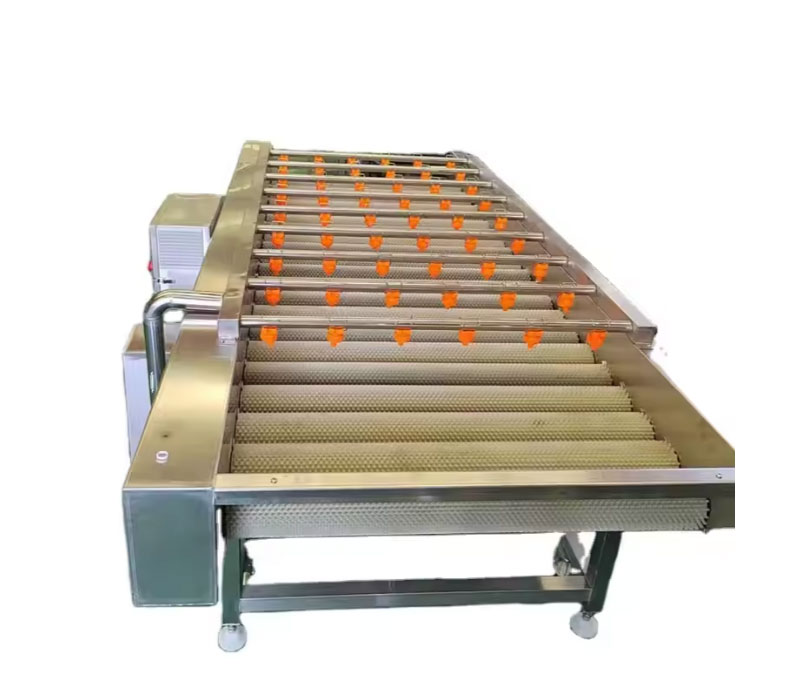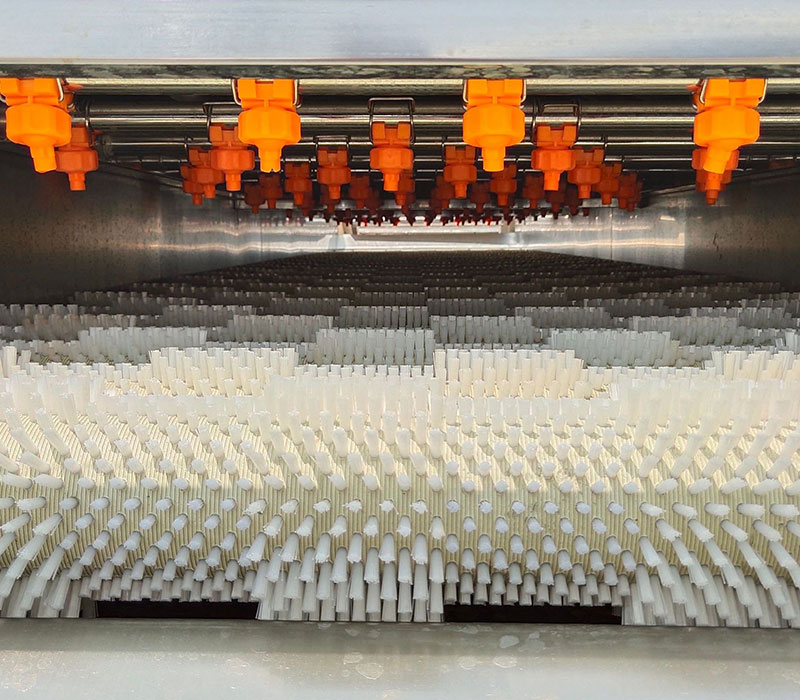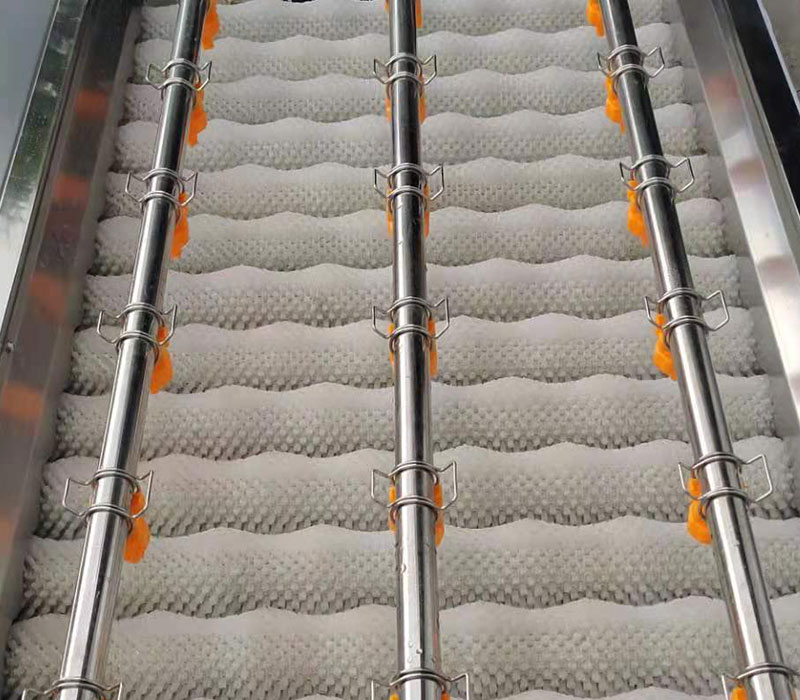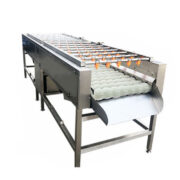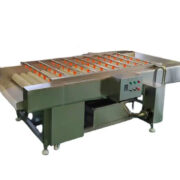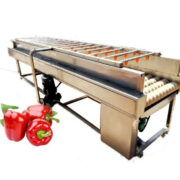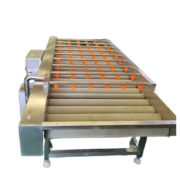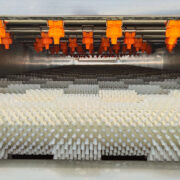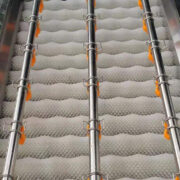Parallel Brush Washing Machine
Main Benefits
- Tailored production: Customized for different processing needs, precise fit.
- Flexible speed: Variable frequency for automatic speed adjustment.
- Multiple cleaning modes: Adapt to various scenarios.
- Efficient water reuse: 80% recycling rate, saves water and labor.
- Durable and easy maintenance: Sturdy, easy to clean, long service life.
- Reduce labor cost: Optimized design for higher efficiency.
- Custom size: Flexible length and width options.
- Adjustable brush: Different hardness for peeling or polishing.
- Smart water system: Optimize circulation and filtration, save water.
- Humanized design: Nice appearance, easy operation, low failure.
- High-quality material: SUS304 stainless steel, corrosion-resistant, safe
Overview
The parallel brush washing machine employs the brush principle and is extensively utilized in cleansing a diverse range of foods. This encompasses various round and oval fruits and vegetables (such as apples, kiwis, navel oranges, tomatoes, tangerines, passion fruits, lemons, and dates), vegetables (like round pumpkins, potatoes, yams, radishes, sweet potatoes, mustard greens, carrots, onions, ginger, water chestnuts, and lotus roots), seafood (for instance, oysters and scallops), and can be utilized to remove hair from pig heads and trotters. The parallel brush washing machine utilizes a motor to drive the rollers to roll in opposite directions, directly contacting the product to generate friction and achieve the peeling effect. Concurrently, it is furnished with a specialized automatic high-pressure spray nozzle that can rinse during the peeling process to realize the dual effects of cleaning and peeling. The hardness of the brush stick can be altered in accordance with diverse products. The hard brush is suitable for peeling root and tuber fruits and vegetables, while the soft brush is used for waxing and polishing of fruits and vegetables. The size and number of brush sticks of the equipment can be customized based on the output and cleaning requirements. It can effectively clean fruits like oranges and apples. During the cleaning process, impurities are adhered to and discharged by the moving brush. The spray device above the equipment effectively washes the surface dirt to attain an efficient cleaning effect and can remove agricultural residues while cleaning. It possesses the characteristics of a large cleaning volume, simple operation, and durability, and is suitable for various types of cleaning and soaking such as vegetables, fruits, and aquatic products. It is outfitted with a bubble generating device to enhance the cleaning effect, and the sediment can be discharged through the discharge port to ensure the effectiveness of cleaning.
The parallel brush washing features an attractive appearance and convenient operation. It has numerous advantages including rapid cleaning, high efficiency, low energy consumption, continuous cleaning, and a long service life. The equipment adopts a cleaning approach that combines high-pressure spraying and brush friction. The box is fabricated from high-quality stainless steel, possessing good corrosion resistance and easy cleaning characteristics, and meeting national food hygiene standards. The entire machine has a rational structural design, is easy to install and maintain, has no noise, and has a low failure rate. This equipment is particularly suitable for cleaning operations in various vegetable processing, aquatic product processing, and meat processing enterprises, and is widely used in the mechanical cleaning, peeling, and removal of pesticide residues of vegetables and fruits. Applicable locations include large-scale processing industries, food processing plants, dried fruit processing centers, food distribution centers, and many other occasions.
Videos
Features
- Stainless Steel Construction: Entire box crafted from 304 stainless steel, 2mm thick compliant with food industry standards.
- Spray Device: Automatic post-cleaning spray reduces secondary pollution.
- User-Friendly English Control Panel: Speed adjustable with waterproof buttons, easy and visually appealing operation.
- Parallel Feed Port: Ensures smooth entry of raw materials into the cleaning equipment.
- High-Pressure Spray System: Final rinse eliminates foam residue, protecting the product from damage.
- Adjustable Nozzles: Detachable nozzles for easy cleaning, adjustable angles for efficient washing.
- Double-Layer Hair Roller: Quickly disassembled for easy maintenance, ensuring ultra-high cleanliness and zero damage.
- Quiet Gear Motor: Reduction motor with multi-sprocket drive, smooth operation, low noise, and wear resistance.
- Inclined Discharge Port: Facilitates automatic discharge, improving work efficiency.
- Efficient Motor: High-efficiency pure copper motor with low power consumption, stable performance, and long operating times.
Specifications
| Model | PBWM1500 | PBWM-2000 | PBWM-2500 | PBWM-3000 |
| Capacity (Kg/h) | 700 | 1200 | 1800 | 2000 |
| Power (Kw/h) | 1.1 | 1.5 | 2.2 | 3 |
| Voltage (V) | 110/220/240/380/415 | 110/220/240/380/415 | 110/220/240/380/415 | 110/220/240/380/415 |
| Weight (Kgs) | 180 | 240 | 280 | 320 |
| Size (mm) | 1580*850*800 | 1980*850*800 | 2580*850*800 | 2780*850*800 |
FAQ
Why a parallel brush washing machine is worth the investment?
The parallel brush washing machine enhances work efficiency and achieves high cleaning standards, making it an excellent investment for food processing.
– High-Quality Materials: Constructed from 2mm thick 304 stainless steel, ensuring corrosion resistance and compliance with food industry standards for long-lasting durability.
-Safe and Reliable: Rigorously tested for leaks, with a sewage valve for easy wastewater discharge.
– Efficient Cleaning: Combines brush action with high-pressure spray, effective for cleaning various foods, including:
– Fruits: Apples, kiwis, oranges, tangerines, lemons, and more.
– Vegetables: Potatoes, radishes, carrots, onions, sweet potatoes, and more.
– Seafood: Oysters, scallops, and more.
– Others: Effective for cleaning pig heads and trotters.
-User-Friendly Operation: Simple interface and thoughtful design for easy installation and maintenance, suitable for various processing companies.
-Wide Applications: Ideal for large-scale processing industries, food processing plants, dried fruit centers, and food distribution channels, accommodating different cleaning, soaking, and peeling tasks.
– Customized Service: Machine length, width and brush quantity, brush type can be tailored to meet specific output and cleaning requirements.
What are the steps to install and debug the parallel brush washing machine?
1. Choose equipment location and level the feet.
2. Connect water inlet and outlet pipes securely.
3. Power on and verify correct motor phase sequence.
4. Test run to ensure all components function properly.
5. Adjust brush pressure and speed as needed.
6. Check water circulation and spray nozzle effectiveness.
7. Calibrate conveyor belt speed for optimal cleaning.
8. Ensure safety features are operational.
9. Conduct a full cleaning cycle with test materials.
10. Fine-tune settings based on initial results.
What are the operating procedures for the parallel brush washing machine?
Firstly, fill the water tank.
Then, connect the power supply and switch on the power.
Next, place the materials to be cleaned and adjust the speed of the roller to obtain the optimal cleaning effect.
Finally, after cleaning is completed, gather the cleaned materials.
What precautions should be taken when operating the parallel brush washing machine?
– Avoid placing materials exceeding 150mm or under 10mm in diameter to prevent blockages.
– Do not reach into the roller area while the machine is running.
– Remove gloves and secure long hair before operating the machine.
– Ensure the water pump doesn’t reverse for uninterrupted operation.
– Regularly clean the water tank filter for smooth equipment performance.
– Do not adjust the speed regulator during machine shutdown
What is the repair and maintenance process for the parallel brush washing machine?
To ensure the smooth operation and longevity of the parallel roller cleaning machine, timely and consistent maintenance is essential. Below are key repair and maintenance guidelines for optimal machine performance:
Daily Maintenance:
Cleaning and Sanitization: After each use, thoroughly clean the machine to maintain both internal and external hygiene. Regularly clean the water tank and filter tank to prevent the buildup of impurities, which could negatively impact the machine’s performance.
Quarterly Maintenance:
Lubricating the Transmission Chain: Periodically check the transmission chain and add an appropriate amount of lubricating oil. This ensures smooth operation and reduces wear and tear on the chain.
Transmission Motor Maintenance: Inspect the motor to ensure it is operating correctly. Clean and lubricate the motor as needed based on usage, and check the wiring and positioning. Make adjustments if necessary to maintain optimal performance.
By following these regular maintenance practices, you can not only reduce the likelihood of equipment malfunctions but also improve the overall efficiency and lifespan of the machine.
What are the troubleshooting steps for the parallel brush washing machine?
Fault: Abnormal Noise from the Water Pump
– Possible Cause: This issue typically arises from insufficient water in the pump body or the presence of foreign objects obstructing the pump head.
– Solution: Ensure the water level is adequate. If the water level is sufficient, shut off the pump and inspect the pump head for foreign objects. Clean any obstructions to restore normal operation.
Fault: Abnormal Noise from the Chain Transmission
– Possible Cause: Noise from the chain transmission usually indicates severe chain wear, leading to improper gear engagement.
– Solution: Regularly inspect the chain for wear. If significant wear is detected, replace the chain promptly to maintain equipment safety and functionality.
Fault: Inadequate Cleaning Performance
– Possible Cause: Inefficient cleaning often results from excessive wear on the wool roller, diminishing its cleaning capability.
– Solution: Assess the wool roller for wear. If severe wear is evident, replace the wool roller to enhance the machine’s cleaning efficiency.
For any additional issues encountered during operation, it is advisable to reach out to professional maintenance staff for immediate inspection and repair to ensure the optimal functioning of the equipment.

